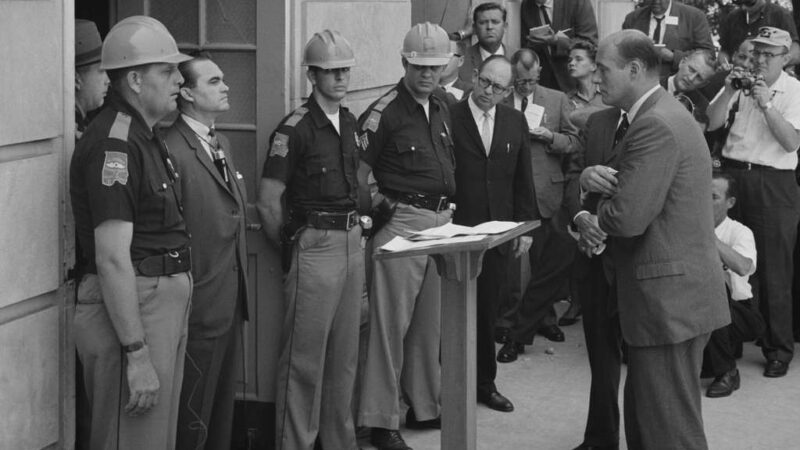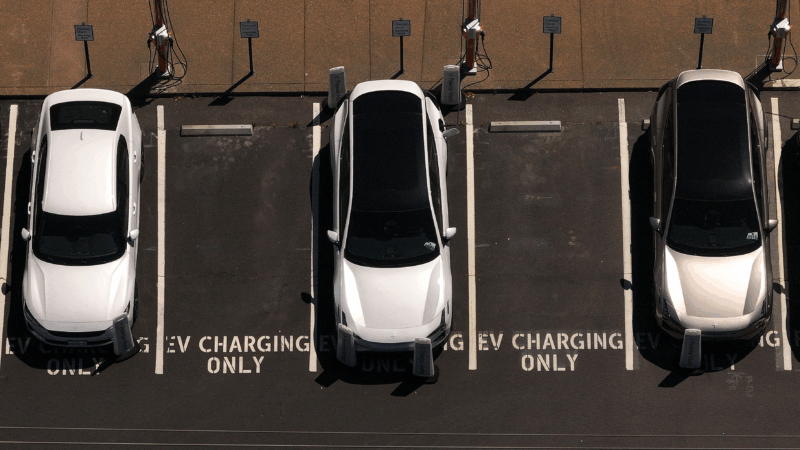The Anniston Depot: All Fired Up
Under the shade of a tent, Army Incinerator spokesperson Mike Abrams described what was happening on a closed circuit video monitor as an M-55 rocket, filled with a gallon of liquid nerve agent — Sarin — made its way down the conveyor belt.
‘What we see is the rocket at the punch station and the top hole about the size of your thumb is a vent. Underneath we will have 2 additional punches come up about the size of your little finger and that is where the agent is drained.’
Drained, but not burned. The Sarin is stored in a thousand gallon tank until the Army has collected a large enough amount to put through another furnace. Meanwhile, Abrams, who’s spent years getting ready for this day, is unable to mask his emotion.
‘This is quite exciting. Here we go! The fuse has just been cut off the end of the rocket, now we’ll see the rocket moved on that television monitor it will move from right to left and we will see a second cut momentarily.’
The rocket is cut into 8 pieces, and moved onto a conveyor belt into a furnace that burns at 1100 degrees.
‘That rocket is now history. This community is one rocket safer.’
There are tens of thousands more to go, but getting started has been the biggest battle in this community.
‘It’s a sad day.’
Rufus Kinney, spokesperson for Families Concerned about Nerve Gas Incineration stood alone by his car with a sign reading ‘Anniston is a human Sacrifice Zone.’ Kinney had fought to legally force the Army to adopt a newer weapons destruction technology here: Neutralization.
‘This community has a right to have that alternative considered for it, just as has happened already in Kentucky, and Colorado, and Maryland, and Indiana. All of which rejected incineration and are now perfectly
happy with neutralization: low temperature, low pressure and no emissions.’
Kinney also doesn’t think the community is prepared for an emergency. Local schools are still working on constructing over-pressurized rooms to be used as shelters. The Army has promised not to burn the liquid nerve agent during school hours, OR to transport weapons during school hours from outdoor igloos where they’re currently stored into the incinerator. Army officials have maintained all along that the weapons pose the greatest danger to the community not in an incinerator, but
sitting in their earthen bunkers. And many here believe them.
‘I’m happy that the beginning of the end has started.’
Keith Howland is one of the closest residents to the incinerator.
‘I mean I would have preferred that our public officials had the presence of mind to demand neutralization a decade ago, but right now if we waited for that, that means we would be held, our whole community would be held under this threat for another 4 to 6 years without any improvement in the probability of being injured.”
The Army estimates it will take 7 years to destroy the Anniston stockpile.
How George Wallace and Bull Connor set the stage for Alabama’s sky-high electric rates
After his notorious stand in the schoolhouse door, Wallace needed a new target. He found it in Alabama Power.
FIFA president defends World Cup ticket prices, saying demand is hitting records
The FIFA President addressed outrage over ticket prices for the World Cup by pointing to record demand and reiterating that most of the proceeds will help support soccer around the world.
From chess to a medical mystery: Great global reads from 2025 you may have missed
We published hundreds of stories on global health and development each year. Some are ... alas ... a bit underappreciated by readers. We've asked our staff for their favorite overlooked posts of 2025.
The U.S. offers Ukraine a 15-year security guarantee for now, Zelenskyy says
Ukrainian President Volodymyr Zelenskyy said Monday the United States is offering his country security guarantees for a period of 15 years as part of a proposed peace plan.
Electric vehicles had a bumpy road in 2025 — and one pleasant surprise
A suite of pro-EV federal policies have been reversed. Well-known vehicles have been discontinued. Sales plummeted. But interest is holding steady.
A ‘very aesthetic person,’ President Trump says being a builder is his second job
President Trump was a builder before he took office, but he has continued it as a hobby in the White House.







